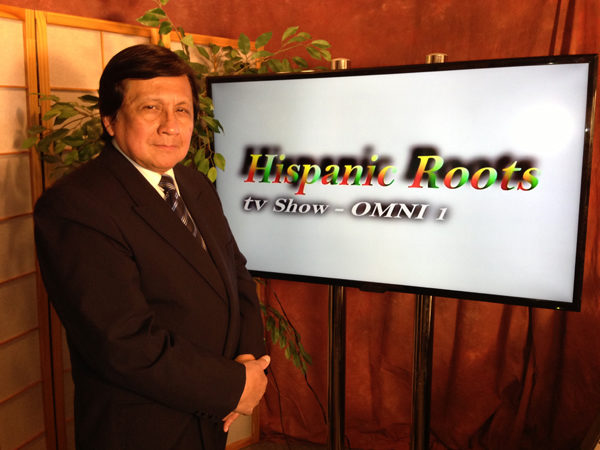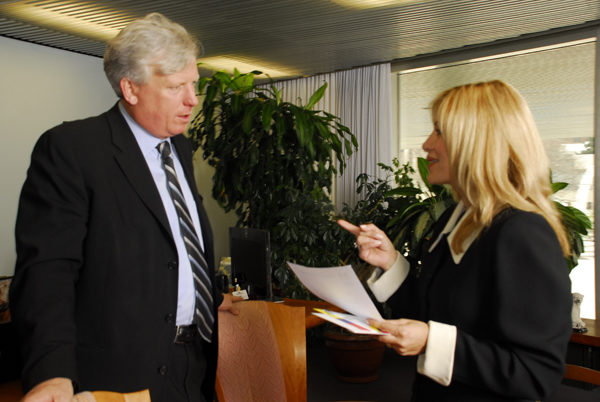Voices in the Void

By Natalie D’Amico
Over 4,000 Latin Americans risked deportation last year—some back to lives of violence and poverty in the crossfires of guerrilla and drug war. And this number could increase since Ottawa applied stricter regulations for immigrants claiming refugee status in February. The search for a new home leaves most newcomers with few possessions, resources, and contacts, let alone a strong grasp of English. Where would a Hispanic refugee learn about these crucial changes?
Sure, a few mainstream papers carried the story, but initially none included the voice of any ethnic group, much less the Hispanic one. But Radio Voces Latinas, a Spanish-language radio station in Toronto, moved quickly to relay these changes to the community and connect Hispanics with experts who could provide more information. “The whole system is changing,” announced Martha Pinzon, Radio Voces Latinas host. “What does this mean for people who are just arriving? What does this mean for those who applied for refugee status a year ago?”
In issues that are crucial to the multicultural face of Canada, ethnic media are often the fastest way to communicate with a particular minority. However, the Latin American press is largely ignored by Canadian media. The quality isn’t up to industry standards, and the community itself is relatively new. But if it disappears, the voice of one of the fastest growing minorities in Canada may be lost. Fixing this problem, however, is as complicated as the Latin American audience it serves.
“We are still an invisible community,” says Eduardo Urueña, the editor-in-chief of El Popular, a Spanish-language daily. “We lack experience in the community because the majority of us came here to work, to forge a future for our families. And the time passed us by in work, work, work.” The result, says Urueña, is an overall lack of representation of Hispanics in Canada in positions of power. Many professionals have arrived but eschewed the uphill process of validating their degrees. Those who have made the effort often stick to their fields and take advantage of opportunities in the English-speaking majority. But others often settle for low-paying jobs and broken English, which makes Hispanics hard to find. They are scattered geographically, with no barrio latino like there is a Little Italy or C hinatown in Toronto.
hinatown in Toronto.
Why does El Popular struggle for ad revenue? Most national advertisers don’t recognize the value of these unique media in ethnic communities. National advertisers often represent a slim portion of community newspapers’ advertising dollars, and in the case of El Popular, they account for nada.
Due to this lack of finances, many Spanish-language publications and radio stations resort to simply translating the news that runs on mainstream media. “Whenever I open a Hispanic newspaper here, and I see just reruns of what I just read in the other papers, I feel disappointed because I know more can be done,” says York University Hispanic studies professor Martha Batiz. “Because the talent is there. Capable people are working there.”
The result is an unfortunate cycle: readers trade in their Spanish newspaper for the higher quality of mainstream media, leaving papers like El Popular with fewer eyeballs to catch the attention of advertisers. At $1 an issue, a circulation of just over 10,000, and much of its ad revenue coming from local Latin businesses, the paper has few resources for original reporting. For the most part, the experience and training is there. Urueña worked as a journalist in his native Colombia. Pinzon has been in broadcasting for over 20 years.
Nestor Castro also has decades of experience. The one-man unit behind one of three local Hispanic television programs produced in Toronto has been working in journalism for 35 years. Walking into the basement of his house, where the show is mostly filmed and edited, is like stumbling into the walk-in closet of a big-time production company—computer screens, televisions, props, lighting, a teleprompter, and hundreds of tapes. In this cramped space, Castro has been producing, shooting, and editing Hispanic Roots for the last seven years. The one-hour weekly show that airs on OMNI Television covers local events, profiles Spanish-speaking professionals, and explores topics relevant to the Latin American community.
 Castro’s main competition is the TeleLatino Network, Canada’s only national Hispanic and Italian television channel, created in 1984. TLN is seen in almost six million homes from coast to coast, and it broadcasts in English, Italian, and Spanish. Upfront, TLN is the Latin American community’s first line of representation on Canadian television, available 24 hours, seven days a week. Its programming includes classic telenovelas, coverage of soccer games, and news from Latin America. But this media giant faces criticism from its own demographic for the one type of show it’s missing.
Castro’s main competition is the TeleLatino Network, Canada’s only national Hispanic and Italian television channel, created in 1984. TLN is seen in almost six million homes from coast to coast, and it broadcasts in English, Italian, and Spanish. Upfront, TLN is the Latin American community’s first line of representation on Canadian television, available 24 hours, seven days a week. Its programming includes classic telenovelas, coverage of soccer games, and news from Latin America. But this media giant faces criticism from its own demographic for the one type of show it’s missing.
“They want local programming. They want to know why we don’t do a half-hour news show in Spanish,” says Sharon Mejia, production coordinator at TLN. “Whenever you go out into the community, into the events, as much as people are really happy that you’re there, they want to know. They bombard you with questions of when are we gonna get a show?” The only local programming TLN produces are two-minute segments covering a variety of Hispanic events, which air sporadically on the network. Everything else is fed by satellite, mostly from the United States.
Economically, it seems that TLN is in the best position. It has the facilities—a sophisticated recording studio, a hall of editing suites, a decked-out control room—but it’s missing the people who can dedicate the time and energy needed to produce a show.
“They’re not interested in the community,” Castro says about TLN’s programming. “You can see they don’t cover anything. The only one who covers our community is me.” But in reality, Hispanic Roots has its share of critics. Most Latin Americans aren’t even familiar with Castro’s show, with its seemingly outdated graphics and poor quality.
“He goes to these Hispanic events, he puts the camera there, films for one hour, and puts that on the show,” says Waldemar Tello, who used to work for TLN. He knows Castro has the experience and makes the best of what he has. But he c
oncedes that most of the problems with Hispanic media can be traced to funding, and working for them requires a lot of personal sacrifice. “Everybody wants a Spanish show, but nobody wants to support it.”
TLN is still easily the most accessible representative of the community to non-Hispanics. Mejia says that its main focus is romancing that sense of nostalgia that Latin American immigrants  have for their home countries. “We try to bring educational programming to viewers to represent the community as rich in food, in culture, in customs, values,” she says. Perhaps bringing all of these elements together will help create what some would agree the Latin American community needs most in Canada: unity.
have for their home countries. “We try to bring educational programming to viewers to represent the community as rich in food, in culture, in customs, values,” she says. Perhaps bringing all of these elements together will help create what some would agree the Latin American community needs most in Canada: unity.
“Our people have been accustomed to seeing with their pockets, hearing with their pockets, feeling with their pockets,” says Father Hernan Astudillo, the founder of Radio Voces Latinas. Eight years ago, Astudillo wanted to take an alternative, grassroots approach to the radio that would serve as a voice for Latin Americans in Toronto—a station by the community, for the community. Voces Latinas is run almost 80 percent by volunteers, a practice some Latino journalists question. Radio Ondas Hispanas is the only other Spanish radio station in Toronto. Everyone working there is on payroll, although there is the occasional volunteer. According to owner Fabian Merlo, Ondas Hispanas’s main focus is the news, whereas Voces Latinas attempts to engage the whole community in its broadcasts. But it tries to keep its staff up-to-date by bringing local and South American journalists to hold workshops on radio production and how to best present the news.
 Pinzon is the host of one of the station’s most popular live shows, heard from Brampton to Ajax. The Neighbours is recorded in a small studio in Astudillo’s basement; the first hour of today’s show features a local naturopath, who is a regular guest.
Pinzon is the host of one of the station’s most popular live shows, heard from Brampton to Ajax. The Neighbours is recorded in a small studio in Astudillo’s basement; the first hour of today’s show features a local naturopath, who is a regular guest.
As the guest reacquaints himself with listeners, Pinzon manages the phone line and researches the topic at hand on the internet, while keeping an attentive ear to chime in with her own comments or questions. It’s a low-profile job, but she sees it as an enormous responsibility.
“The community has faith in you, in what you’re doing, because they know that you’re looking for resources. They know you’re not going to tell them something that isn’t true,” says Pinzon. Working in Canada has led her to change her focus from getting her name out there to serving the community around her, whether that means relaying important news from the government or reaching out to help a listener in need.
One such listener called Pinzon in a panic. Desperate and with little to no English, she asked Pinzon for help with her alcoholic brother. Pinzon recalls contacting five organizations, researching and seeking referrals to detox clinics in English. Acting as an intermediary and translator, she handed over all the information to the listener. Three days later, she got a call from her saying they had saved her brother and that he was finally receiving treatment for his addiction. “A piece of information at the right time can make the difference in a person’s life.”
And this fact remains, despite shortfalls and cutbacks in Hispanic media. There are many who believe that ethnic media are not only here to stay, but to grow. A 2011 study on the state of the media done by the Pew Research Center in the United States revealed that the only area of the media that is expanding is Hispanic.
Journalist John Miller believes the same is true in Canada for all ethnic media. “New immigrants are incredibly loyal to getting the news in their own language,” says Miller, who conducted a survey of ethnic media on behalf of the Department of Canadian Heritage in 2004. He found that there were actually more other-language dailies than English papers in Toronto. Miller says there is a lot of potential for mainstream media to partner with these publications, which don’t have access to sophisticated distribution and advertising systems.
Such partnerships make sense to Pinzon. Her dream is to make journalism that is accessible to both Spanish and English speakers. She wants to see a multicultural television newscast in which the anchors report in fluent English, but with their cultural accent. This was her intention behind Now What, a bilingual show she hosts on Rogers Television that covers current affairs and cultural events in the community. A typical segment in the show will feature Pinzon’s introduction in Spanish, followed by an interview with someone in English, or vice versa.
On air at Voces Latinas, one voice sounds a little out of place. Matt Brubacher is a coordinator for Unison Health and Community Services, a non-profit organization that offers clinics, counseling, and a variety of programs and services in Toronto. It’s common to hear representatives of organizations like Unison appear on the show to promote their programs, but they usually do so in Spanish. Brubacher only speaks English. Why appear on a Spanish radio show? Turns out there are a lot of Spanish-speakers in the communities Unison serves, and Pinzon’s show is popular. But as it was his initative, Brubacher figured he’d give it a shot. And he manages well against Pinzon’s quick wit and fast pace—she often cuts him off to translate into Spanish.
“Matt, something in Spanish they teach you?” Pinzon asks him. He hesitates. “Un poco,” Brubacher says. A little. “You have to learn Spanish,” says Pinzon. Maybe more should heed her advice.
Natalia D'Amico was the Visual Editor for the Summer 2013 issue of the Ryerson Review of Journalism.












































